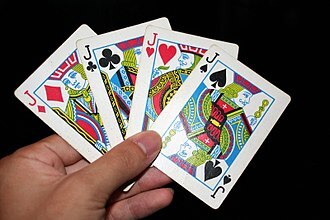Jack
 The proper name Jack, first seen in 1218, is from Old French Jacques and Latin Jacobus (Jacob). Jack is usually regarded as a more informal version of John. The Scottish form of John is Jock.
The proper name Jack, first seen in 1218, is from Old French Jacques and Latin Jacobus (Jacob). Jack is usually regarded as a more informal version of John. The Scottish form of John is Jock.From the 14th century, the generic term ‘jack’ was often applied contemptuously to anyone, particularly to lower-class young men. The term knave also referred to young men, particularly to male servants in a royal household or to young men swaggering about and causing trouble.
What about the Jack in a deck of cards? In 16th century decks of cards, the Knave was the card between a Ten and a Queen. However, when holding a hand of such cards, a K on the corner of a card could refer to either a Knave or a King.
In the 1670s, some decks of cards began to include a J for Jack instead of a K for Knave. This variation did not become widespread until 1864 when an American manufacturer of playing cards changed the K for Knave to J for Jack and published countless decks of cards with this new variation. The Knave card disappeared.
Over the centuries, the word ‘jack’ has been used in numerous ways:In the late 14th century, jakke, a generic term, referred to any mechanical device.Jack and Jill, who went up the hill, is from the 15th century.In medieval times, people sometimes saw spooky flickering lights appearing at night over marshy ground. In 1563 scientists called this light ignis fatuus (foolish fire), light now attributed to the combustion of gases from decomposing organic matter. This light was called Jack’s lantern. Jack O’Lantern, from the 1660s, was a night-watchman. The carved face on a Hallowe’en pumpkin was first called a Jack O’Lantern in American English in 1834.Jack-in-the-box, from the 1560s, was the name for a card sharp or a cheat. Other meanings for Jack include a peddler who sells wares from a temporary stall (1690s), an unborn child, a type of gambling game, a hermit crab, a large wooden male screw, the sacrament, and various mechanical devices. Jack-in-the-box, the toy, is from 1702.Jack Sprat, from the 1560s: a small light man, not to be confused with Jack Weight.In the 1570s, a jack referred to the any of the various appliances used by servants.Jack, from the 1600s, referred to a sailor.Jack of all trades, from the 1610s: a person handy at any kind of work.Jack, a small flag flown from a bow of a ship, is from the 1630s; e.g., a Union Jack. A jack is usually smaller than a regular-sized flag.Jack, as a device for pulling off one’s boots, is from the 1670s.Jack, as a portable device for lifting anything heavy, is from 1703. The verb ‘to jack up’ using such a device is from 1860.A jack-knife, from 1711, is a pocket-knife larger than a pen-knife (a knife for sharpening your quill pens). Other meanings include a kind of swimming dive, 1922; a type of tractor-trailer accident, 1966.Jack Frost, is from 1826.Every man jack, from 1812: generic name for any ordinary or working-class man.Jack-in-the pulpit, from 1833, is type of turnip.In the US, jack was first used from the 1880s in reference to an unknown stranger.Jack, as slang for money, is from 1890. The verb ‘to jack up’ the price is from 1904.Jack-hammer, a pneumatic drill, is from 1913.
There are many other obsolete, rare, or rude versions of the word jack.
Note: The is the longer version of this item. A shorter version was posted on Linked In and Facebook.
Reference: Online Etymological Dictionary, https://www.etymonline.com/
https://en.wikipedia.org/wiki/Jack_(playing_card)
Published on March 14, 2023 18:15
No comments have been added yet.



